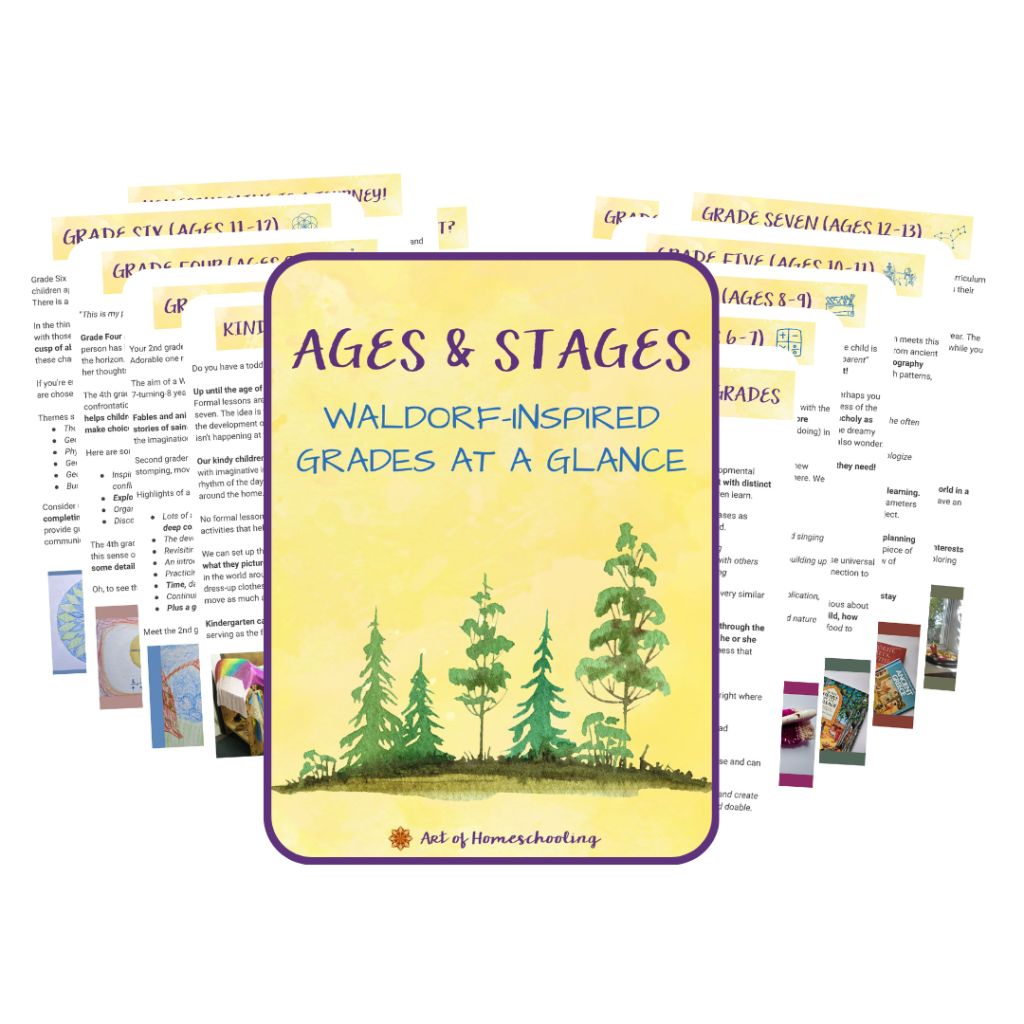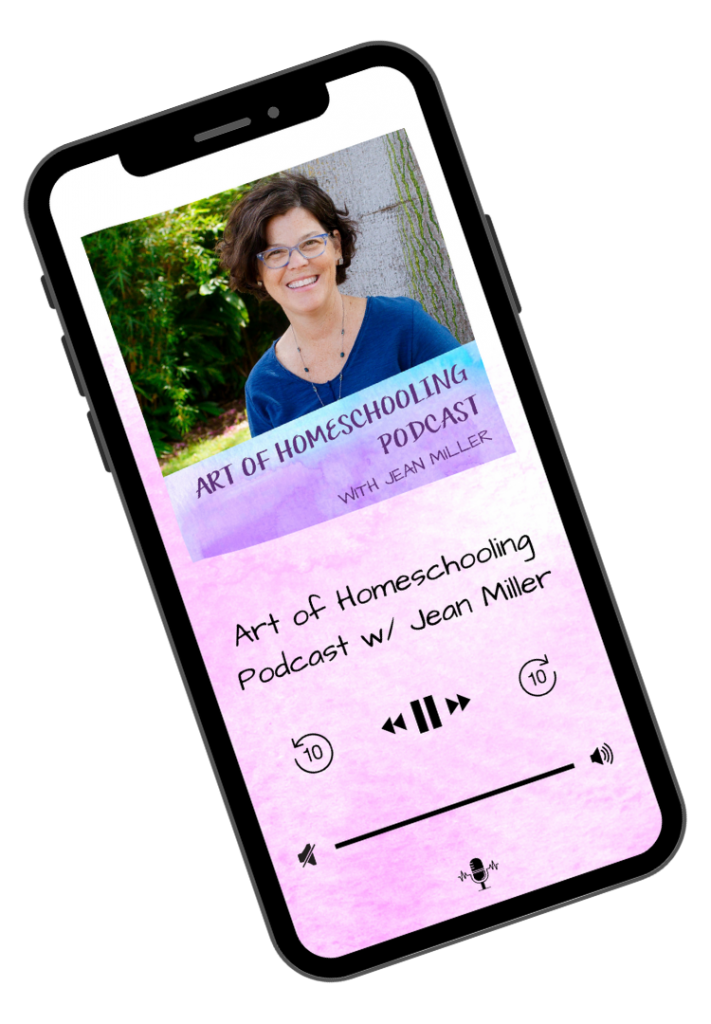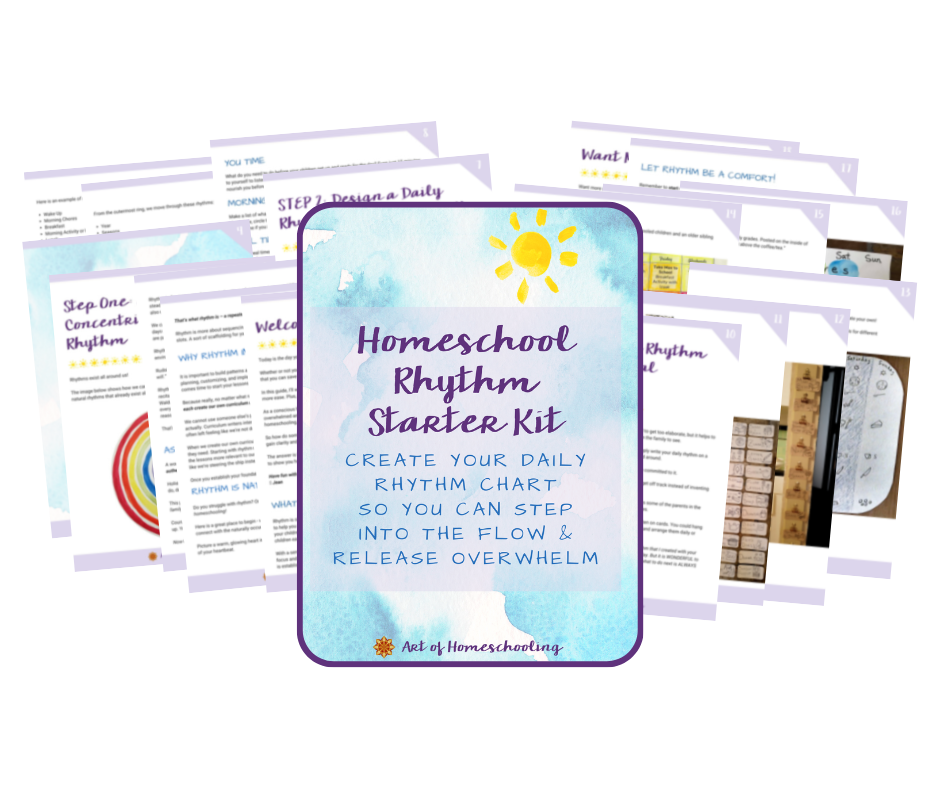Episode 185
Welcome to the Art of Homeschooling podcast! I’m Jean, veteran homeschool mum of over 25 years and I’m so happy you’re here for this episode all about homeschooling first grade, including a peek into my Waldorf-inspired first grade basket.
This is part of a series of episodes where we’re working our way from kindergarten through eighth grade, building a wonderful library for you to refer back to, again and again, whenever you need inspiration and guidance about Waldorf-inspired homeschooling in the grades.
The first in the series, all about homeschooling kindergarten, is Your Kindergarten Basket. If you have a kiddo between the ages of 3 to 6, don’t miss that episode.
And if you’d like a wonderful, printable resource for your homeschooling library, please go get your 🌟FREE Ages & Stages Guide: Waldorf-Inspired Grades at a Glance.🌟This is a concise roadmap of homeschooling kindergarten through eighth grade. Don’t miss it!
In this episode, I’m sharing my First Grade Basket with you ~ what’s in it, why, and how the first-grade materials meet the needs of your growing child. This episode is all about putting together your First Grade Basket!
When Should I Start Homeschooling First Grade?
One of the most delicate questions I hear about homeschooling (especially Waldorf homeschooling) is “When should I start first grade?” It’s a big one!
First grade is that first big step across the rainbow bridge from the realm of early childhood into middle childhood and elementary school.
It can seem like a big step! And one that we often fret about getting right.
When thinking about when to start first grade, I can offer some food for thought. And then I encourage you, dear homeschooling parents, to do some research and follow your intuition.
The general recommendation is that the first grade child is 6 turning 7 during the first grade year.
Some Waldorf schools recommend the child turn 6 before Easter or by early spring before starting first grade. Others recommend the child turn six by sometime in June.
And then some mainstream brick-and-mortar schools don’t require the first grade child to turn 6 until late summer or mid-September.
Just to give you an example, our closest Waldorf school has a birthday cut-off date for grade placement of June 1st. Local public schools in Ohio can choose the cut-off date of either August 1st or September 30th so our local school district has a cut-off date of September 30th. That’s a wide range of almost 6 months ~ from spring to the end of September!
Just remember, you know your child best, and you get to decide when to start first grade.
If you want to hear more about that big question of “Is my child ready for first grade?” head over to the Art of Homeschooling podcast archives and dig up Episode #37, “How Do I Decide Homeschool Grade Level?” for a detailed discussion about determining your homeschooled child’s grade level.
From Kindergarten to First Grade
In a homeschool setting, the transition from kindergarten to first grade can be very gentle.
Some homeschoolers choose to start the year with a kindergarten rhythm and then build up to a first grade rhythm as their child shows readiness.
Or you may find like I did that your kiddo is not ready for a full first grade year. And then you can gently ease back into a kindergarten rhythm. This was the case for me when my boys, just 16 months apart, were making this transition.
And I’m SO glad I had the freedom to wait until they were both ready for more formal instruction to start first grade.
Here are some similarities between the kindergarten and first grade rhythms.
In both, you can weave circle time activities like finger plays, verse recitation, and songs into your day. You can bring age-appropriate fairy tales, create watercolor paintings, and share puppet plays. All of these activities encourage whole-body movement and the imagination, which are so important in these early years that children are learning primarily through doing.
The main differences then between kindergarten and the grades are the gentle shift of the rhythm of activities and the making of making of main lesson books to record the learning.
The Kindergarten Rhythm
In the kindergarten years, the rhythm of the week revolves around a story shared at the beginning of the week. Then the songs, puppet plays, and artistic activities each day are connected to that one story. All of these activities can be woven informally into everyday life.
The First Grade Rhythm
When we begin first grade, that rhythm shifts to a two-day lesson rhythm where we share a story one day and engage in an artistic activity connected to the story. Then the next day we recall or retell the story and summarize it, often by writing a short title, caption, or summary into a main lesson book.
In essence, we move from bringing engaging activities to crafting those activities into more formal lessons with specific skills in mind as we begin first grade.
The First Grader
When homeschooling first grade, the most important thing to consider is whether your child connects with and is deeply nourished by the story material and themes of the first-grade year.
Skills development such as writing, reading, and mathematics can unfold around these themes at your child’s own pace.
The first-grade child may radiate a feeling of “the world and I are one.”
At this stage, children are shifting from learning through the will, or by doing and imitating in the kindergarten years, to learning through feelings and their imagination.
The first grader may also express with his words or curiosity about the world that “I’m ready to learn.”
Children at this stage often express a love for their parents and teachers. They want to do what is asked of them. They are ready for learning and direct instruction. And their capacities for learning and taking in knowledge increase.
If you’d like a printable list of these ideas, don’t forget to grab the FREE Ages & Stages Guide so you can discover more about each stage of learning and bring your children what they need to learn and grow.
The Basket for Homeschooling First Grade
So what’s in my first grade basket? Let’s dive in!
- Beanbags ~ for lots of lively and playful learning. Bean bags are great for tossing while reciting a poem or singing a song.
- A collection of fairy tales or folktales ~ for introducing the alphabet through story. With the Waldorf approach, we usually read or tell fairy tales and folktales, then draw a picture and show how a letter can be found in the image. It’s a magical process that is meant to mimic how humans first created written language with symbols created from pictures (I’ll share a few of my favorite resources for the stories in the Resources section below!)
- Chalkboards and dry-erase boards, large and small ~ for learning to write and decode the alphabet by copying words, titles, captions for illustrations, and building up to simple sentences. Sand trays and sidewalk chalk are also fun!
- Blank books, main lesson books, or blank paper and a folder or binder ~ for recording the learning. If you’re new to main lesson block learning, you’ll find more about main lesson block learning here in Episode #107. Making main lesson books is a way to capture story summaries and takes the place of textbooks and worksheets.
- Acorns, glass gems, or beans ~ for counting and introducing all four mathematical processes: addition, subtraction, multiplication, and division in a hands-on way.
- Chunky wool yarn and size 10 knitting needles, wool felt, embroidery floss and quilting needles, and other natural craft materials ~ for developing fine motor and practical life skills through handwork
- Liquid watercolor paints and heavy watercolor paper ~ for exploring the stories you share and the world of color
- Time in the outdoors ~ for experiencing the awe and wonder of the natural world through nature study
Resources for the First Grade Basket
As a homeschooling parent, what materials can support you as you prepare to teach your first-grade kiddo?
Here are a few of my favorite resources for first grade in addition to the supplies mentioned above…
Some of these are referral links. You can read my full disclosure policy here.
- My favorite resource for fairy tales ~ The traditional book to use for this is The Complete Grimm’s Fairy Tales from the Pantheon Library with an introduction by Padraic Colum.
- For folktales, I also like Best-Loved Folk Tales from Around the World by Joanna Cole.
- For choosing fairy tales ~ Here’s another great resource, a free article from the Waldorf Online Library by Waldorf teacher Joan Almon called Choosing Fairy Tales for Different Ages.
- Resources for learning to teach the lively arts ~ I highly recommend the courses from Waldorfish. Grade One Painting is phenomenal. Or if you’re entirely new to the Waldorf arts or painting and drawing, I recommend Waldorf Art for Beginners. This course is actually available as one of the masterclasses (one of 35+ as a matter of fact!) inside the Inspired at Home community.
Encouragement for Homeschooling Parents
To wrap up, I want to share a little encouragement if you’re starting first grade for the very first time.
You’ve got this!
Honestly and truly. You can take a deep breath and just begin.
The early elementary years are really for focusing on writing, reading, introducing the four math processes, and laying a foundation for science through time in nature. It can be quite simple.
Choose the stories you bring to your child based on where they are developmentally. And help them expand their language arts and math skills by starting right where they are and helping them make progress. This is the beauty of Waldorf-inspired homeschooling.
So put together your first grade basket and enjoy the learning journey with your kiddos.
And don’t miss other episodes in this Ages & Stages series:
- Kindergarten ~ Episode 182: The Kindergarten Basket
- First Grade ~ Episode 185: The First Grade Basket
- Second Grade ~ Episode 187: The Second Grade Basket
- Third Grade ~ Episode 192: The Third Grade Basket
- Fourth Grade ~ Episode 197: The Fourth Grade Basket
- Fifth Grade ~ Episode 201: The Fifth Grade Basket
- Sixth Grade ~ Episode 204: The Sixth Grade Basket
- Seventh Grade ~ Episode 207: The Seventh Grade Basket
- Eighth Grade ~ Episode 210: The Eighth Grade Basket
Until next time!💜

Rate & Review the Podcast
If the Art of Homeschooling Podcast has inspired you, I’d LOVE it if you could rate and review the podcast on your favorite podcast player! Reviews can be left on Apple Podcasts (iTunes), Podcast Addict, or Stitcher.
Or simply pop on over to lovethepodcast.com/artofhomeschooling and choose where you want to leave your review.
And if you want to show your appreciation for the Art of Homeschooling Podcast, you can buy me a cup of tea!
Never Miss an Episode!
Check Out All the Episodes





